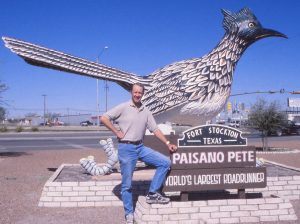Create Nature Center Experiences That Match Visitors’ Reasons for Visiting
In my most recent post, I profiled the work of Dr. John Falk, who I think has produced the most useful insights into nature center visitors that I’ve ever encountered. (If you haven’t read that entry, click here and check it out first. It’ll take you two minutes.)
What makes Dr. Falk’s stuff so valuable is that it’s actionable. You can do things at your nature center to serve the needs of the different types of visitors he has identified. He offers a number of practical suggestions in his book Identity and the Museum Visitor Experience. Here is a condensed version, with some of my own experiences added in:
Explorers. Falk says, “In many ways, Explorers are like serious shoppers or habitués of flea markets; they love to browse and bump into intellectual ‘bargains.’” How do you meet their needs? Always offer new stuff: new displays, new programs, new social media posts. In your exhibits, provide “layered” interpretation that invites them to move down to the finer print if they want more details. And let them wander around in pursuit of their own agenda—Explorers don’t like to be spoon-fed.
Facilitators. What satisfies a Facilitator most is believing that they are a good parent (or grandparent or friend) because they have made their guests happy. So one thing you can do is cater to their guests, who will often (though not always) be kids. You can also give Facilitators tools that make them successful, like the backpack discovery kits that many centers offer. Do you have an interactive exhibit for young children? Many of those children will be in the company of grandparents (a.k.a. Facilitators) who are there to engage with their grandkids. But we old people get tired! Put seating close enough to the exhibit so the adults can interact and rest at the same time.
Professional/Hobbyist. My friend Amy likes to explain, “I don’t shop—I buy.” She isn’t an Explorer, she’s a Professional/Hobbyist. As Falk says, “These visitors are typically on a mission.” Another thing about them is that they are often influencers, sought out by friends to give reviews. And they give critical ones, so get things right. (I visited the newly-opened “Wonders of Wildlife Museum & Aquarium” in my hometown of Springfield, Missouri, recently. In foot-high letters on a prominent wall they printed a quote by forester and conservationist Gifford Pinchot, and spelled his name “Pinchat.” I spent the rest of my visit looking for other things they might have gotten wrong.) Other things you can do to meet the needs of Professional/Hobbyists: connect them with your experts, give them behind-the-scenes tours, and host their meetings.
Experience Seekers. As I mentioned in my last post, I don’t think most nature centers see very many of these. But if you have something iconic at your site, highlight it, and make sure people can take selfies with it in the background. Better yet—make sure your staff and volunteers are trained to offer to take those photos for them! At the Michigan DNR’s Outdoor Adventure Center in Detroit, they have a display that does the job automatically, taking your picture in an “eagle nest” and allowing you to post it on Facebook or email it to all of your pals.
Spiritual Seekers. Falk has more recently taken to using the term “Recharger,” which I like. And nature centers see a lot of them. These are the people who consider your site a “hidden gem” . . . and want it to stay hidden so they don’t have to share it with a bunch of boisterous kids. Enhance their visits by opening your trails early and late, and by putting out lots of benches in quiet, beautiful places. I once saw this taken a step further at the Chesapeake Bay Foundation’s Philip Merrill Environmental Center, where they attached a hard-bound blank journal to a bench with a little chain, and tucked it onto a shelf under the seat. Rechargers entered all kinds of thought-provoking comments, many prompted by entries already recorded there. Cool!
Exercisers. I must confess, I spent most of my years as a nature center manager trying to discourage this group. But I know they would have welcomed a water fountain about halfway out on our longest trail!
Next time—Do you really know who your visitors are, and how they fit into Falk’s categories?

